Burial Vs Cremation Spiritual: Explain!
The spiritual implications of burial versus cremation vary widely across different cultures and religions. Burial is often seen as a way to preserve the body for an afterlife, while cremation is sometimes viewed as a method of liberating the soul.
Each choice carries its own set of beliefs and practices that reflect the values and traditions of individual communities and personal preferences.
The decision between burial and cremation is deeply rooted in spiritual beliefs and cultural traditions. For example, in Christianity, burial has been the traditional method, symbolizing the belief in bodily resurrection.
Conversely, Hinduism prescribes cremation as it is believed to promote the release of the soul from the physical body.
When choosing between burial and cremation, individuals often reflect on their spiritual convictions, seeking a method that honors their beliefs and provides solace to the bereaved.
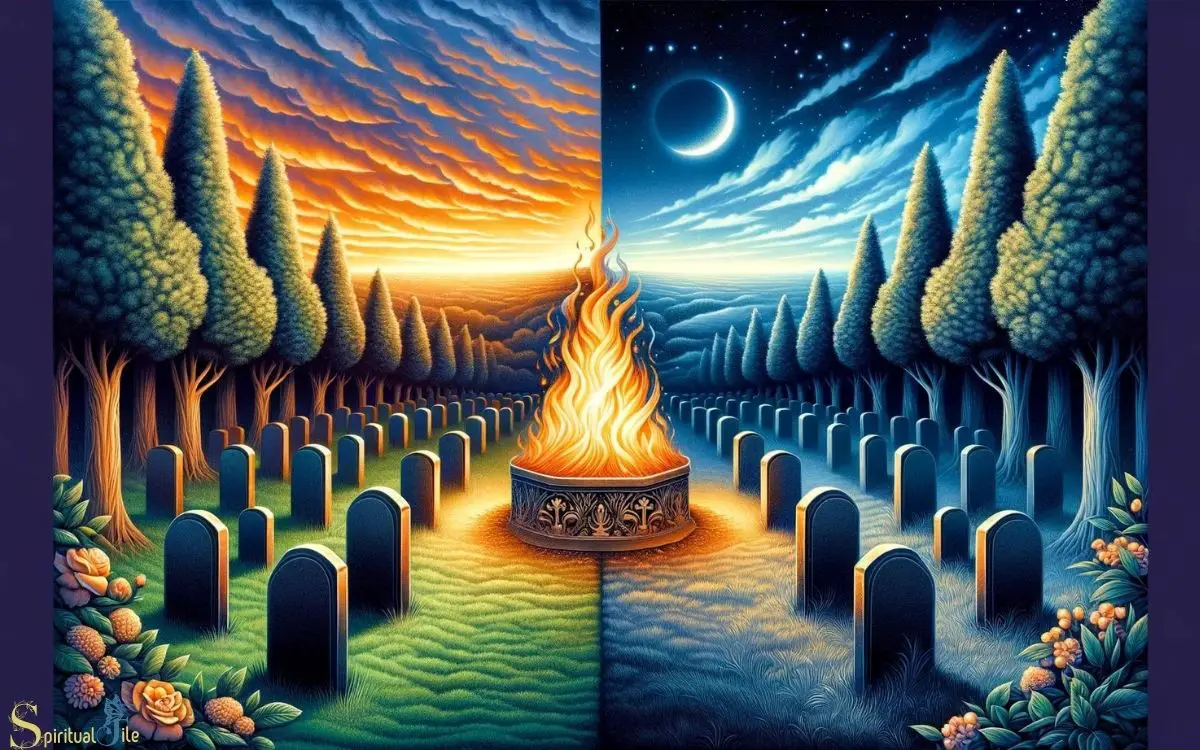
Key Takeaway
9 Aspects: Burial Vs Cremation Spiritual
| Aspect | Burial | Cremation |
|---|---|---|
| Process | The body is placed in a casket and buried in the ground, often in a cemetery. | The body is reduced to ashes through intense heat, typically in a crematorium. |
| Symbolism | Symbolizes the return of the body to the earth and is often associated with resurrection or an afterlife. | May be seen as a transformation or transition of the body into a different form, often symbolic of impermanence. |
| Tradition | Common in many religious and cultural traditions, including Christianity, Islam, and Judaism. | Widely accepted across various cultures, but some religious traditions have reservations or restrictions. |
| Environmental Impact | Requires a plot of land and resources for maintenance, potentially impacting the environment. | Generally more environmentally friendly due to reduced land use and resource consumption. |
| Preservation | Provides a physical place for remembrance and visits at the gravesite. | Allows for the scattering of ashes, keeping them in an urn, or incorporating them into jewelry or art. |
| Personal Beliefs | Reflects a belief in the importance of the body’s resting place and its role in the afterlife. | May align with beliefs about the impermanence of the physical body and the eternal nature of the soul or spirit. |
| Mourning Process | Offers a structured place for mourning and paying respects at the gravesite. | Mourning and remembrance can take place in various ways, often based on personal preferences. |
| Influence on Grief | May provide a sense of closure and a physical connection to the deceased. | Grief and closure can be achieved through alternative means, such as memorial services or rituals. |
| Relevance in Spirituality | May align with religious teachings and beliefs about the resurrection of the body. | Compatible with spiritual beliefs emphasizing the transition of the soul or spirit to the afterlife. |
Religious Beliefs and Burial Rituals
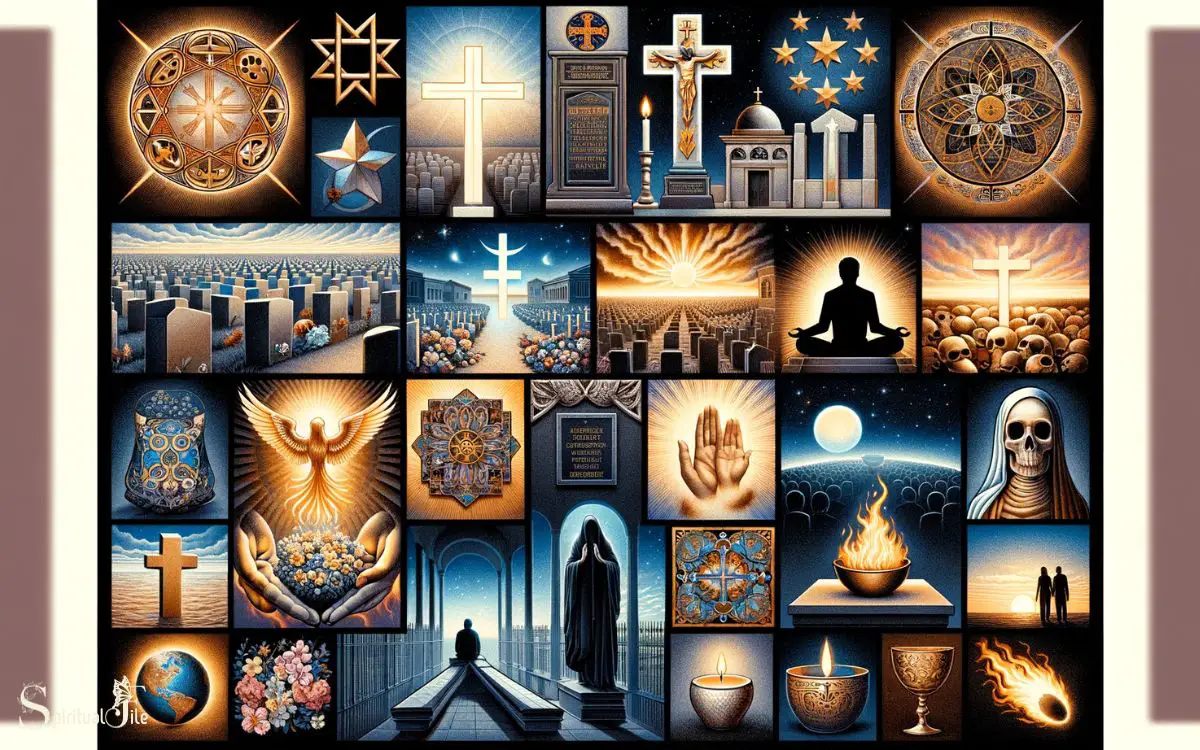
Many religious traditions around the world prescribe specific burial rituals for their followers, reflecting the deeply held beliefs and customs of their faith communities. These rituals often serve to honor the deceased and provide comfort to the living.
For example, in Christianity, the body is typically buried, symbolizing the belief in resurrection. In Judaism, the body is washed, wrapped in a simple shroud, and buried in the earth, emphasizing the equality of all in death.
Hinduism advocates for cremation, believing it helps the soul detach from the body and move towards reincarnation.
These rituals not only hold spiritual significance but also foster a sense of community and support during times of loss. Understanding these practices can provide insight into the values and beliefs of different religious groups.
Symbolism of Cremation in Different Cultures
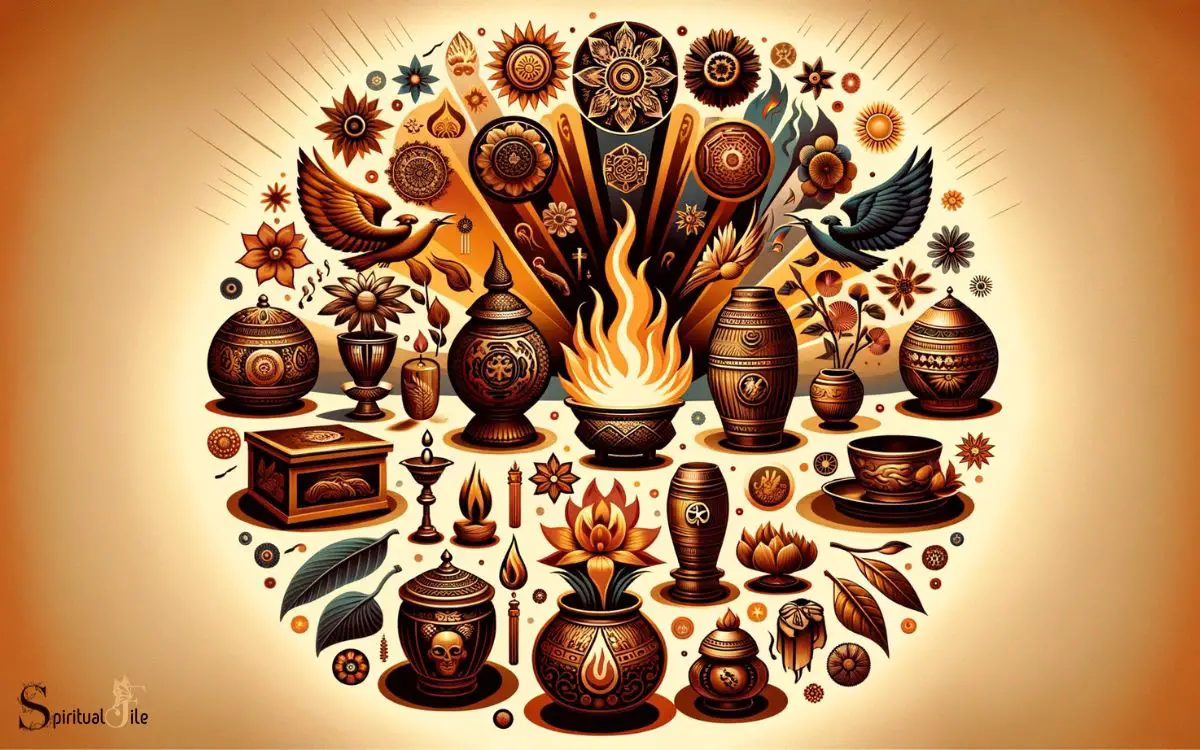
The symbolism of cremation in different cultures reflects diverse spiritual beliefs and practices surrounding the transition from earthly life to the afterlife.
In Hinduism, cremation is seen as the release of the soul from the body, allowing it to move on to the next life. The act of cremation in this culture symbolizes the impermanence of the physical body and the eternal nature of the soul.
In contrast, in Japanese culture, cremation is symbolic of respect and honor for the deceased. It is believed that the act of cremation purifies the soul and allows it to find peace in the afterlife.
Similarly, in Tibetan Buddhism, cremation is seen as a way to release the soul from the cycle of birth and death, allowing it to achieve enlightenment.
These cultural differences highlight the rich tapestry of beliefs and rituals surrounding cremation.
Spiritual Significance of Commemoration
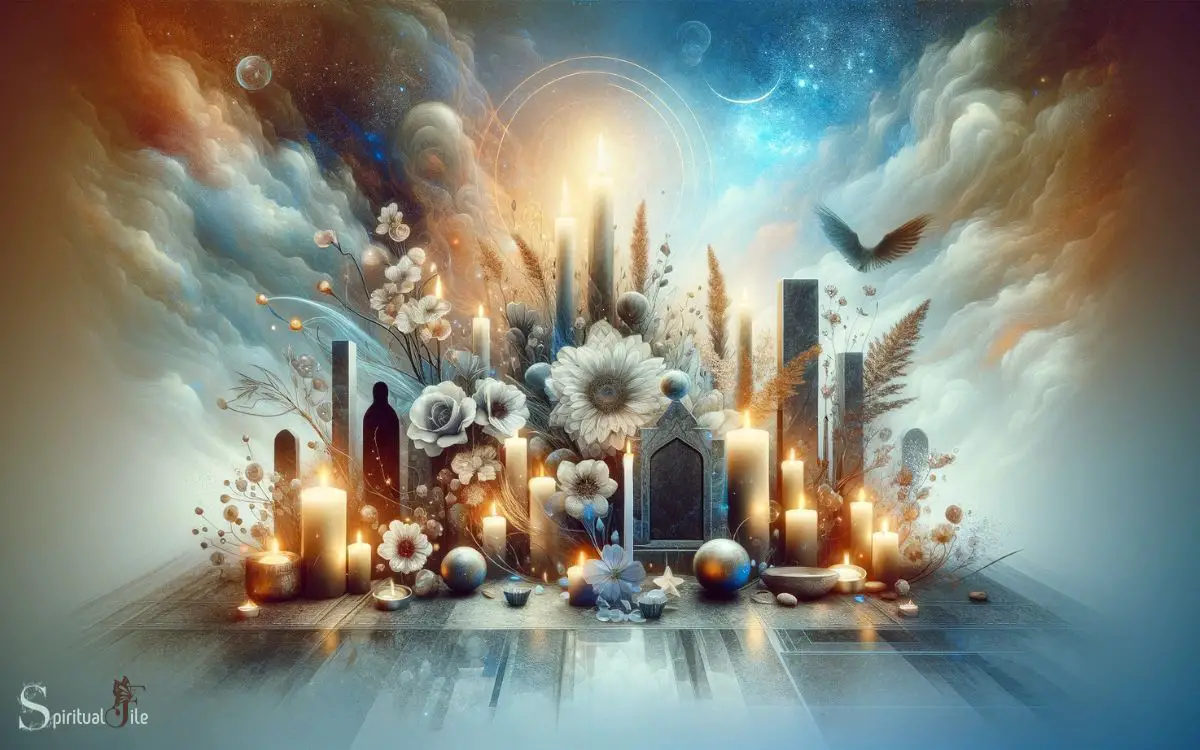
In Hinduism, cremation signifies the release of the soul from the body, allowing it to transition to the next life. Understanding the spiritual significance of commemoration further enriches the understanding of this transition.
Commemoration holds deep spiritual significance as it honors the departed soul and aids in their journey to the afterlife. It serves as a means to express love, respect, and remembrance for the deceased, fostering a sense of closure for the living and facilitating the soul’s onward journey.
Commemoration rituals, such as prayers, offerings, and ceremonies, are believed to provide spiritual support and guidance to the departed soul, ensuring a peaceful transition.
Grieving Process and Burial/Cremation Choice
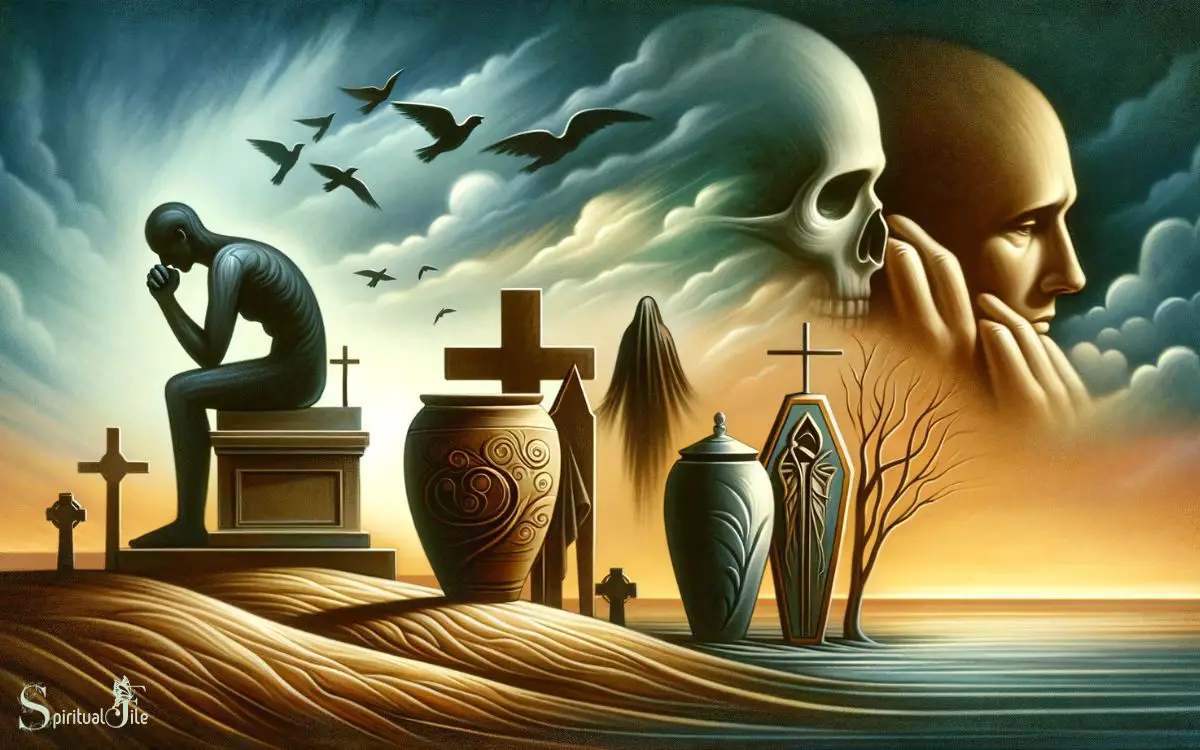
The grieving process following the loss of a loved one, whether through burial or cremation, is a deeply personal and spiritually significant journey marked by various rituals and commemorations.
The choice between burial and cremation can significantly influence the grieving process. Burial often provides a physical place for loved ones to visit and find solace, fostering a sense of connection and continuity.
It allows for traditional mourning rituals and provides a tangible location for the expression of grief.
On the other hand, cremation may offer a sense of release and freedom, allowing the departed to be scattered in meaningful locations or kept close by in an urn.
Each choice can impact the grieving process, and understanding the spiritual and emotional needs of the bereaved is crucial in guiding this decision.
How Do Different Burial Practices Affect Spiritual Beliefs About Death?
Different cultures have varying spiritual and physical death beliefs, which influence their burial practices. For example, some believe in cremation to release the soul, while others prefer natural burials to return the body to the earth. These diverse practices reflect the interconnectedness of spiritual and physical death beliefs.
Afterlife Perspectives: Burial Vs. Cremation
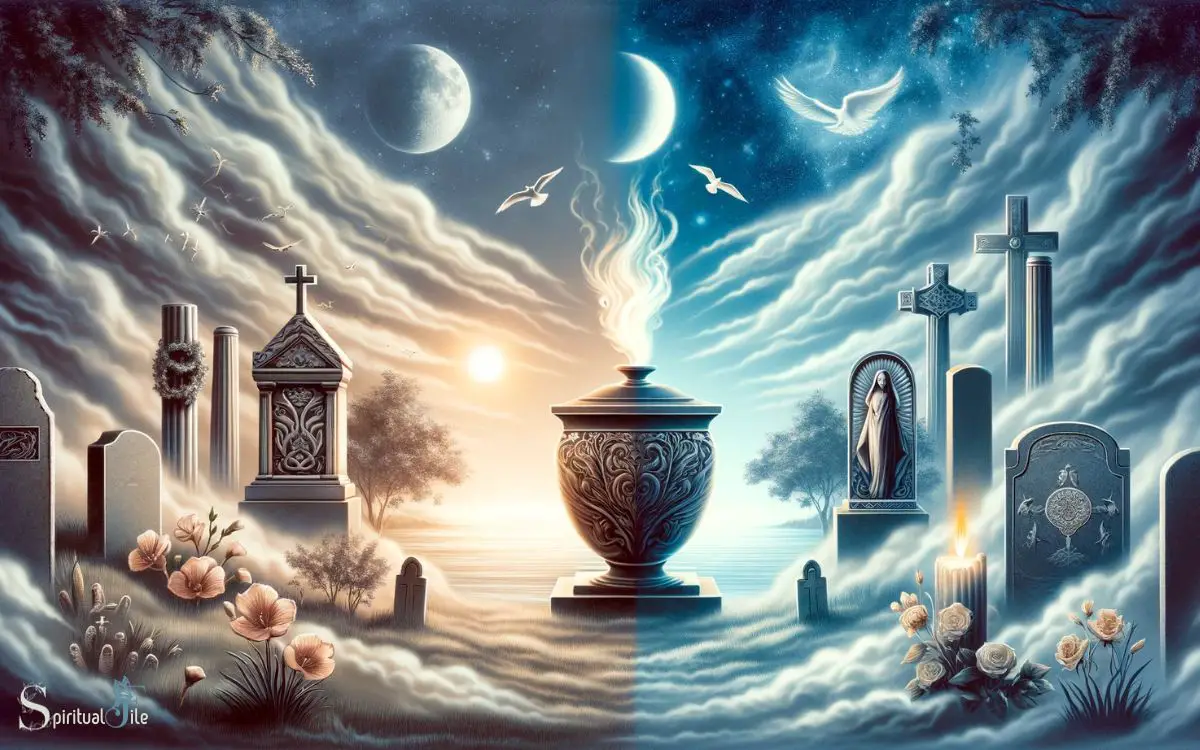
Having examined the impact of burial and cremation on the grieving process, it’s essential to delve into the afterlife perspectives associated with these choices.
In many spiritual and religious traditions, burial is seen as a way to honor and respect the deceased, with the belief that the body will be resurrected or rejoin the soul in the afterlife.
The act of burying the body is often viewed as a way to show reverence and care for the physical vessel that housed the soul during life.
On the other hand, cremation is embraced in various cultures as a means to release the soul from the body, allowing it to transition into the afterlife unencumbered. It symbolizes the impermanence of the physical form and the belief in the continuation of the soul beyond death.
These differing perspectives on afterlife significantly influence the choice between burial and cremation.
Conclusion
In conclusion, the choice between burial and cremation holds significant spiritual and cultural significance.
While burial represents the return of the body to the earth and the continuation of life in the afterlife, cremation symbolizes the transformation of the body into ashes and the release of the spirit.
Both choices offer unique perspectives on the grieving process and the afterlife, ultimately shaping the way individuals commemorate their loved ones.






